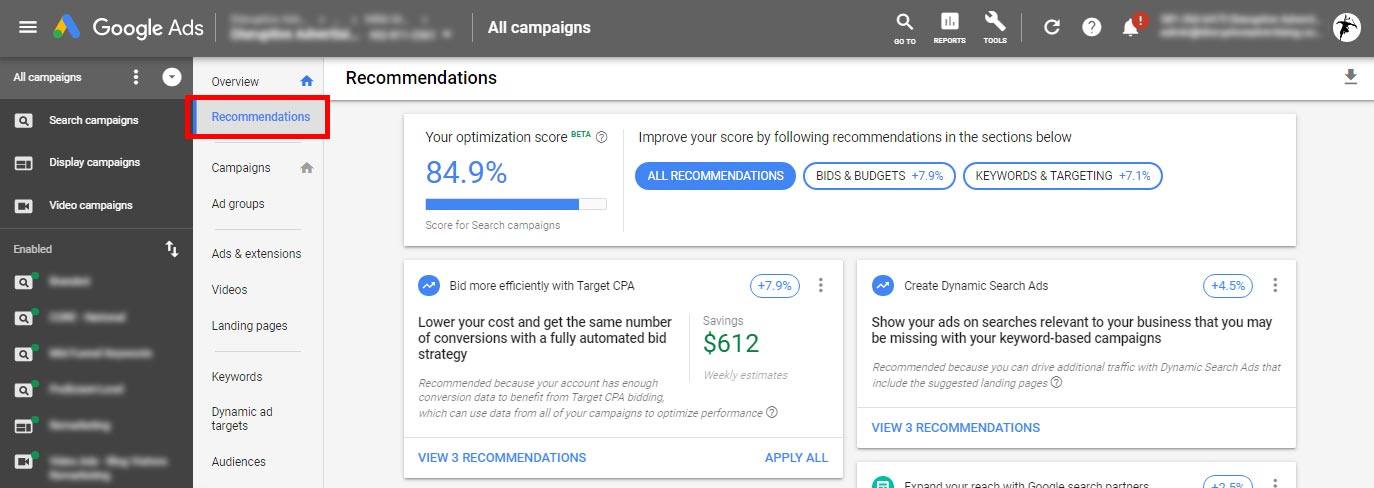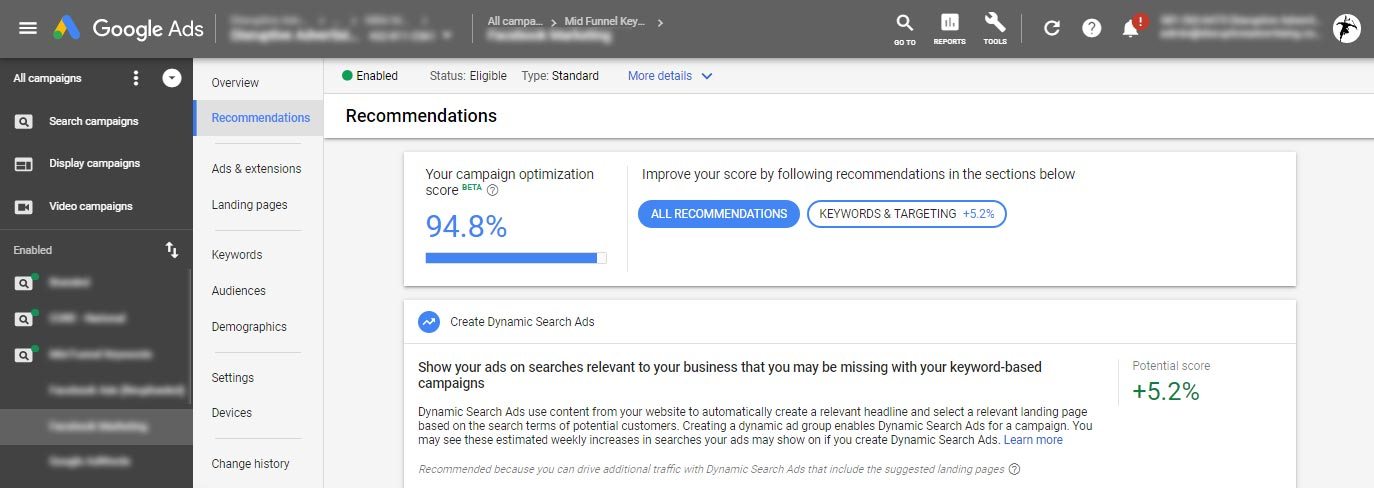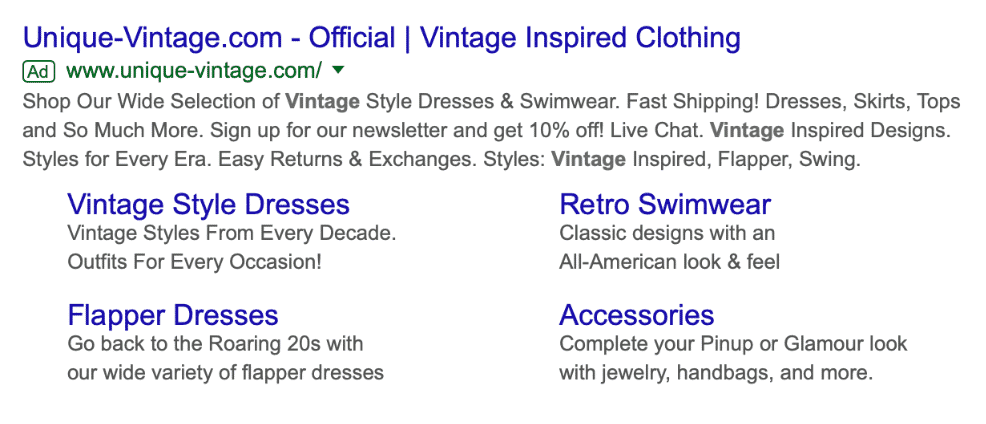Should You Implement All of Your Google Ads Recommendations?
by Aden Andrus • May 9, 2019
Last year, Google rolled out the Optimization Score. Ever since, we’ve all had access to a variety of new recommended tweaks that Google thinks will improve your campaign performance. But should you actually implement these suggested changes?
In this article, we’re going to take a look at what these suggestions entail, how to keep tabs on them and give you some practical advice on how to use your Google Ads Recommendations to improve your campaign performance. Let’s get started!
Where to Find Your Google Ads Recommendations
Although Google Ads has always had those never-ending notifications in the top bar, the Recommendations section of your ad account is actually fairly understated. To see your Optimization Score and Google’s suggestions for your account, click on the “Recommendations” tab in the left-hand sidebar of your account.

As you can probably imagine, the higher your Optimization Score is, the better Google thinks you are doing and the fewer recommendations you’ll have. Of course, Google’s algorithms and the Google Ads platform in general are always evolving, so your score will fluctuate over time, but it’s an interesting metric to watch.
Incidentally, it’s important to note that as of publication, this section is still in beta and only describes the setup and performance of your search campaigns. That being said, the Recommendations tab is an interesting place to explore for ideas on how to improve your account.
The suggestions you see in the Recommendations tab will depend on whether you were looking at a specific campaign or your account in general when you clicked on the tab. This allows you to drill down on a poor-performing campaign and identify opportunities for improvement, which is a nice touch.
For example, in the screenshot above, we’re looking at the account-wide recommendations, whereas the shot below shows recommendations for a specific campaign:

While you won’t always have recommendations for every campaign, Google regularly adds new recommendations as it discovers new opportunities to improve performance, so it’s not a bad idea to keep an eye on this tab.
But what about Google’s actual suggestions? If you’ve been advertising on Google for a while, you’ve probably had some bad experiences where you’ve implemented a recommended change…only to see your ad performance actually drop.
The good news is, things have improved quite a bit lately, but you still need to take your Google Ads Recommendations with a grain of salt—which is what we’ll be discussing for the rest of this article.
Smart Bidding Strategies
Smart bidding strategies have been a big push for Google for years, so they are one of Google most common recommendations. The idea here is that Google has used its wealth of advertising data to create algorithms that can automatically adjust your bids on an ongoing basis to ensure that your ads show up in front of the right people in the right places at the right times.
Now, if you’ve been running your Google Ads account for a while, you’re probably a little gun-shy of Google’s automated bidding options—and with good reason.
A few years ago, using automated bidding was a bit like playing Russian roulette with your ad accounts. You had a chance of getting good results, but most of the time things got worse, not better. In recent months, however, we’ve seen great results for many of our clients from implementing Google’s new and improved automated bidding strategies.
Here is a quick overview of some of the smart bidding strategies you might see recommended by Google:
Maximize Clicks
This bidding strategy is pretty self-explanatory. Google’s algorithm will get you as many clicks on your ad as possible within the constraints of your daily budget. You can set a bid limit, which is nice as it ensures that you won’t end up blowing your budget on a few clicks.
Maximize Conversions
Maximize conversions is similar to the above bidding strategy, but the focus here will be entirely on getting conversions instead of just clicks. Google will go through your budget quickly to get you those conversions whenever possible.
Target CPA
The Target CPA bidding strategy focuses on driving as many conversions as possible at your target cost-per-acquisition (CPA). Though some bids will cost more or less than your target cost, they’ll average out to ensure that you’re staying where you need to overall.
This bidding strategy can work well when you have an average CPA you want to stay near (but not necessarily under for every click you get). Before choosing this, have a good idea of what you can spend in order to maintain profitability when getting a sale, factoring in everything that can lead to a rise in costs or loss of ROI.
Target ROAS
When using the Target ROAS strategy, Google sets your bids to maximize the conversion value as much as possible, optimizing your potential return on ad spend (ROAS). This strategy is similar to Target CPA, but this option is focused exclusively on ROAS while the other looks at the acquisition cost.
Enhanced CPC
Enhanced CPC can be applied on its own stands for “enhanced cost-per-click,” and, while it’s similar to manual bidding, it allows Google to adjust your bid—even if you’ve set it manually. Google will adjust the bid depending on the likelihood for a sale, increasing it if the likelihood is higher and decreasing it if lower.
Whether or not you decide to try any of these smart bidding strategies in your account is ultimately up to you. However, if you haven’t tried automated bidding in a while and Google believes that one of these strategies will save you a lot of money, you might consider trying it out on a campaign or two—just to see what happens. If you do test an automated strategy, though, make sure you keep a close eye on your account for the first few weeks to ensure that everything goes smoothly.
Keywords and Targeting
Google Ads also frequently makes recommendations on ways to improve your keywords and targeting. This is great, because having a machine constantly pore over your keyword performance and search terms can save you a lot of time and headache.
In general, you’ll keyword and targeting recommendations related to the following:
Negative Keywords
Negative keywords are all the keywords that you don’t want your ads to show for. If you’re selling leather couches, for example, maybe you’d want to appear in searches for “leather couches,” “couches,” and “living room furniture,” but not in “upholstered couch.” By adding the last phrase as a negative keyword to your campaign, you could prevent your ad from appearing when users searched for that phrase.
If Google notices that a certain word shows up in a lot of searches that don’t result in a click or conversion, it will recommend that you add that word as a negative keyword. That way, you don’t end up spending money on clicks that don’t provide value for your business.
Keyword Opportunities
On the opposite side of things, sometimes Google will identify search terms that produce good results…but that you aren’t targeting yet. In this situation, Google may suggest that you add those search terms as target keywords or expand the match types of certain keywords.
That being said, you should always review suggested keywords on a case-by-case basis. Back before he started Disruptive, our CEO once added several hundred recommended keywords to an account…and then went home for the weekend. By the time he came back, he had accidentally spent $10,000 extra on those keywords.
It all worked out in the end, but it just goes to show that you should only click “Apply All” when you know exactly what that entails. Also, regardless of how many keywords you add, keep an eye on your account for several days afterward to make sure that your new keywords are actually producing good results.
Dynamic Search Ads
Dynamic search ads use your landing page content to target your ads and match them to search terms that are closely related to the content on your page. Basically, dynamic search ads work a lot like organic search: Google determines what sorts of search queries your pages should show up for and then you pay to run an ad on those search queries.
The advantage of dynamic search ads is the fact that you don’t have to worry about keywords. The disadvantage is that you don’t pick your keywords, so you don’t have complete control over which searches you’ll show up on.
As a general rule of thumb, the more well-established your account is, the less useful dynamic search ads will likely be. If you’ve spent years optimizing your ads and keywords, you probably already know what you need to be targeting. On the other hand, if you’re fairly new to Google Ads or haven’t spent a lot of time in your account, dynamic search ads could be a great way to identify a variety of new opportunities.
Problems and Oversights
All of Google other common recommendations are typically basic best-practice tips. For example, if you have disapproved ads, buggy audience sources, problems with your conversion tracking or are missing out on some potentially beneficial ad elements, Google will let you know.
Most of these fixes are fairly simple, self-explanatory and should be applied or taken care of manually to ensure that your ads are working properly. However, when it comes to adding ad extensions to your account, keep the following in mind:
Sitelink Extensions
Sitelink extensions are one of the most frequently used types of ad extensions. They allow you to add short snippets of information that essentially act as CTAs, which when clicked will take users to key pages of the company’s site.
In the example below, the ad features links to key pages that will help searchers get where they need to go. Some, for example, will want to look the law team over and get a quick look at their experience, others will want to see testimonials to establish trust, and others still will see “Facing Criminal Charges?” and immediately think “YES!” while they click.
Sitelink extensions can be used for almost any ad campaign. When used for campaigns designed to attract users early in the buying cycle, they should contain links to introductory information, like “About Us” pages and information on key products or services. Use them to show users the information they’re most likely to look for when making a purchasing decision and highlight what makes you different.
Call Extensions
Call extensions allow you to feature your business’s phone number next to your site URL. On desktop, this will just show up as a phone number that users can enter in to a mobile device; on mobile, this number is actually clickable, and with only two taps someone can be calling your office.

Call extensions are a good choice if you have the bandwidth to handle an influx of calls from people who need appointments, reservations, consultations, or even just answers to quick questions like “can you make that gluten free?” They don’t take up a lot of space, and it’s always better to have it for the client if they need it than not. Remember, convenience is a huge asset when people are in a hurry, and mobile users typically are.
The only time not to use this extension? If you don’t actually want unscheduled phone calls. Many businesses aren’t equipped to just pick up the phone every time it rings, so having their phone number listed online wouldn’t be the way to go.
Callout Extensions
Callout extensions are a little different from other options on the list, and they’re a somewhat newer type of extension. They create CTAs within your ad, but they’re not clickable. Instead, they simply work by giving you more room for information you want to share in the ad itself.

In the above example, “Free Moving Quotes,” “24/7 Live Support,” and “Long Distance Moving” are callouts that you might add in. You get 25 characters for each individual call out, which gives you valuable real estate that you can use to share important, click-winning information.
These extensions are most frequently used to concisely highlight benefits of the products or services you’re advertising, like “Free moving quotes” above. These quick call outs can provide the information needed to differentiate you from your competition, so don’t write them off just because they aren’t hyperlinked.
That being said, if you’re able to convey the value of your brand or your offer in the ad as it stands and there isn’t a need to add more, skip this one and rely on other extensions instead.
Structured Snippet Extensions
Structured snippet extensions allow you to create hyperlinked, clickable headlines that send users to key pages on your site.
Structured snippet extensions are, essentially, like sitelink extensions on crack. They’re more noticeable, and the additional information under each link will increase the likelihood of relevant clicks. Use the text to explain what makes you different and the value each page has. The example above features links to different categories of ecommerce products, but you can also feature “About Us” or “Testimonial” pages just like you would with the sitelink extensions.
Typically it’s going to be best to choose either site link extensions or structured snippet extensions. Decide what will work best for your ad campaign and then go from there.
Location Extensions
Location extensions add your business address to the bottom of your ad, along with your operational hours if you feature it. When users click, they’ll be taken to a Google map showing your location, and they can instantly get directions to where you are.

Location extensions are an excellent choice if you have a brick-and-mortar location where you actually serve clients. They’re an essential choice if geographic location will heavily influence whether or not someone decides to do business from you. A marketing consultant may not need this, even if they have a physical location; a hair salon, however, definitely would.
Price Extensions
Price extensions allow you to quickly showcase how much a given product or service costs, listing an item, linking to its specific URL, and then featuring pricing and qualifying information.

Price extensions are a great way to make your ad even more competitive by offering up highly relevant information up front. Price, after all, is a huge factor that can shape someone’s buying decision. The transparency of having the price readily available up front can increase clicks if you’re within the range that the searcher is looking for, and get them to click on your ad instead of a competitors’. It’s better to start with what you know instead of what you don’t, after all.
And if the price is out of range from what the searcher is looking for? That’s okay, too, because you don’t want to pay a lot for clicks that have no chance of converting. This extension can actually prevent that.
Price extensions can work well when you want to feature a few key products or services in particular. They may not work well for ecommerce stores with diverse items that come with extensive differences in cost, but they can be particularly valuable if your low cost is a selling point.
While there are a variety of ad extensions that you can use (and that Google will recommend), it’s up to you to decide which extensions will add to your ad…and which ones will detract or distract from your messaging.
Conclusion
In the end, your Google Ad Recommendations are just that: recommendations. You are the one who ultimately has to pay for your clicks, so you’ll need to decide whether or not each recommendation is worth implementing.
After reading through most of the common recommendations that you’ll see, however, you should be in a good position to make educated decisions about which Recommendations to apply and which ones to dismiss. But, even if you make a mistake, you can always go back and fix it later, so don’t worry that you’re going to irreversibly break your account if you click “Apply”.
By the way, if you would like some recommendations on how to improve your account from an actual marketer, let me know here or in the comments. We’d love to help!
What do you think of Google Ad Recommendations? Are they something you use or ignore? Any thoughts on the information presented here? Leave your thoughts in the comments below!







